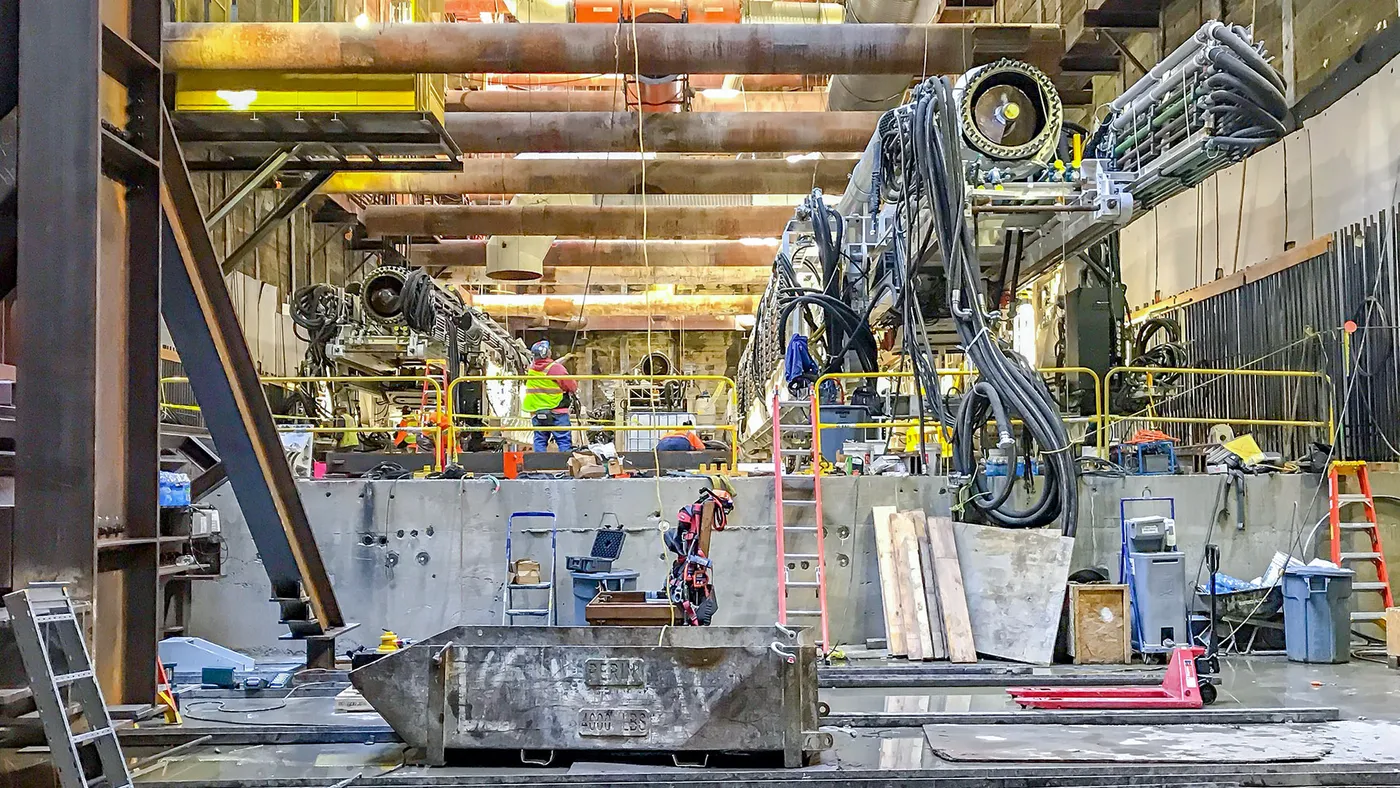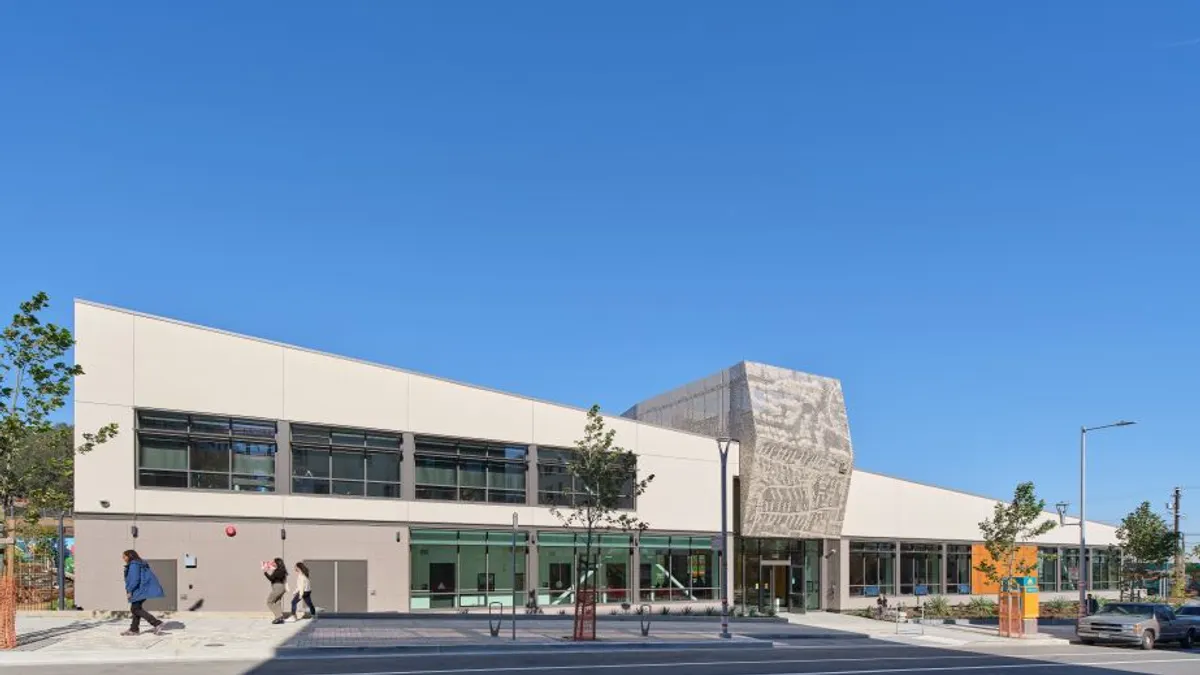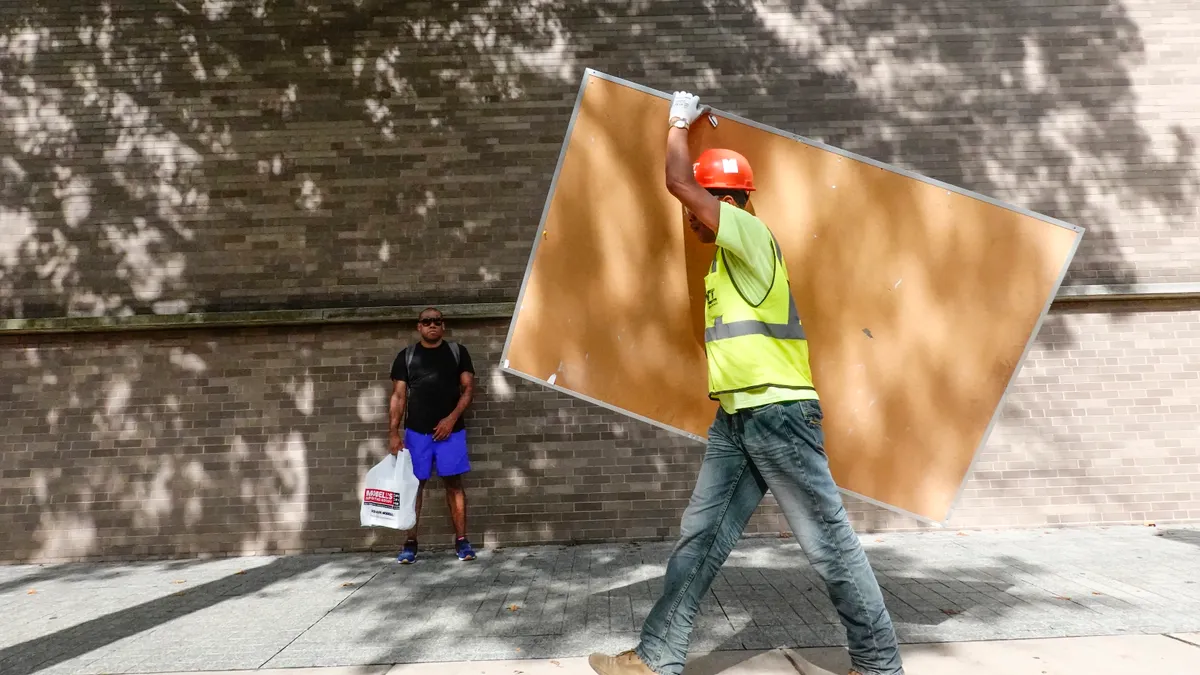Tutor Perini Corp., one of the largest contractors in the country, was cited 244 times for health and safety violations on its jobsites over the past decade — far more than any commercial or residential builder — and that doesn’t count two high-profile investigations last year, according to a Construction Dive investigation.
Inspectors from OSHA cited the company between five and 55 times a year from 2012 through 2021, the most recent data available. Initial fines totalled $1.2 million. Key findings were shared with the agency and the company for review.
OSHA was four times more likely to find a violation when inspecting a Tutor Perini jobsite than one of its large rivals, according to an analysis of OSHA data for the 30 largest commercial contractors by revenue. Each OSHA inspection of a Tutor Perini site resulted in about 1.5 violations, on average, compared to the median of 0.33 for its peers.
The Los Angeles-based company’s total included its subsidiaries, such as Black Construction Corp. and Lunda Construction Co., but no joint ventures. Construction Dive treated its peers — competitors with annual revenue above $3 billion — the same.
The company, founded in 1949, is known for its work on large commercial and infrastructure projects such as California’s high-speed rail project and the BART San Francisco Airport Extension.
Tutor Perini had 1.5 initial violations per inspection, the most among its peers
As one of the industry titans, Tutor Perini should set an example for safety, experts say.
Even though the company cites its commitment to safety in its 2021 and 2022 annual financial reports filed with the Securities and Exchange Commission, it does not mention OSHA violations or any litigation stemming from them, indicating top management does not view the lawsuits or potential reputational damage as material financial risks. Nor is the company on the radar of OSHA’s federal program to reform serial offenders, a program that tracks companies with multiple repeat violations over time, which has only marked smaller contractors.
Tutor Perini also continues to win big-ticket bids, such as a joint venture on the $4 billion Capital Beltway project in the Washington, D.C., region last September. The project was halted after the lead partner in a private consortium known as Accelerate Maryland Partners, Australian firm Transurban, pulled out of the job.
CEO Ron Tutor noted on the company’s fiscal year 2022 earnings call last week that the cancellation of major projects such as the Beltway widening had hurt the company’s bottom line. Tutor said the company lost a record $11 billion in potential new work last year after projects were scrapped because they were over the owners’ budget.
Despite these issues, the company noted several smaller wins from last year, including the $260 million Eagle Mountain-Woodfibre gas pipeline project in British Columbia, Canada, and $126 million for military facilities in Puerto Rico.
Contested fines
OSHA violations are often contested and litigated across the industry. This means that large contractors pay much less than they’re fined, said Kevin Barry, head of the United Service Workers Union’s Construction Division, which represents 30,000 workers.
“They get an attorney. They go into OSHA, they nickel and dime it down.”
Tutor Perini told Construction Dive that it appeals many of its OSHA violations, but would not provide an estimate of final fines and violations.
“Depending on the outcome of our appeals, we believe that both the number of violations and the ultimate total amount of fines paid will be substantially less,” the company said in a statement.
Tutor Perini's initial OSHA violations included 86 "serious" violations
OSHA said in a statement its “goal is to get employers to fix the hazards. Sometimes, we lower the penalty to get protections earlier … so focusing on the fines is not always the best measure. When setting a penalty, OSHA begins with the maximum penalty, then adjusts based on a variety of factors.”
The agency, however, was unable to provide numbers of contested fines for any of the 30 contractors, nor how many violations were reduced or removed following appeals.
Tutor Perini told Construction Dive that the majority of its violations were classified as “other-than-serious.” However, 86 of its violations, or 35%, were labeled “serious” by OSHA inspectors, according to Construction Dive’s analysis, more than double the next closest company.
Other safety metrics
Tutor Perini declined to be interviewed, but in response to emailed questions said its safety record is top of mind and, using two other safety metrics, says it does well compared to its large competitors.
“As one of the largest civil works contractors in the United States, we regularly compare our safety performance against industry averages, and our overall safety record is strong,” Tutor Perini Vice President of Corporate Communications and Investor Relations Jorge Casado wrote in a statement to Construction Dive.
Casado denied that the company operates unsafe jobsites, and said it measures safety using the Total Recordable Incident Rate, a formula that tallies total injuries multiplied by 200,000, divided by total hours worked. The company also tracks the Lost Time Injury Rate, which measures the rate of injuries that result in a lost day’s work.
The company’s TRIR was 1.58, compared to the industry average of 2.7 and its LTIR was 0.4 compared to 0.9, according to the company’s 2021 ESG report.
However, these metrics have come under scrutiny as safety measurements. A report published by the Construction Safety Research Alliance in 2020 claims TRIR is unreliable due to its lack of precision and association with fatalities, and is statistically invalid for comparing businesses.
A study by SafeWork Australia in 2013 found Lost Time Injuries records injuries that can vary in severity.
“Of the various performance data employed across the business, government and not-for profit sectors, it is increasingly clear that the use of LTI rates is particularly problematic and deserves special attention,” the study’s authors wrote.
Current troubles
Tutor Perini’s safety problems continue beyond the time frame of Construction Dive’s analysis.
The California Public Utilities Commission investigated a Tutor Perini jobsite in San Francisco following a fire in June 2022 on a Municipal Transportation Agency (Muni) jobsite. The fire suppression system and ventilation fans didn’t activate, according to a report submitted by a fire inspector, and an internal review by Muni found that Tutor Perini shut off the fire suppression system based on the cost of an accidental discharge, NBC Bay Area reported.
The San Francisco Municipal Transit Authority told Construction Dive that the investigation into the incident was completed, and that the cost of the issues would be covered by the project’s liability insurance.
Casado said in a statement: “Safety is of utmost importance to Tutor Perini on all of our jobsites. We will continue to work collaboratively with SFMTA to ensure that safety is and remains a top priority as we complete our work on the Central Subway.”
More recently, Tutor Perini’s safety problems on the Los Angeles Purple Line rail system drew nationwide attention. The $2.4 billion Los Angeles County Metropolitan Transit Authority project was halted last October along a 2.6-mile stretch following safety concerns and incidents dating back almost two years. LA Metro sent repeated warnings to the contractors prior to the shutdown.
LA Metro’s Michael McKenna, senior executive officer of project management, and Kenneth Stewart, the director of contract administration, sent a letter to Tutor Perini and its joint venture partner, Torrington, Connecticut-based O&G Industries. The appendix lists 50 injuries since July 2021, including workers struck by rebar or hit in the face by air hoses and others who fell into embankments or to the ground. Additional safety issues included hazardous and dusty tunnels and a lack of following fall protection requirements.
Work on the Purple Line resumed Nov. 4, following a site evaluation and written promises from the contractors to revamp their safety efforts.
Tutor Perini submitted an updated safety plan to LA Metro that included a root-cause analysis. The contractor found most incidents — 15 — were caused by a lack of planning and hazard assessments. Lack of training was responsible for 13 incidents, followed by housekeeping and material storage with 10 incidents.
The company’s root-cause analysis “identified many areas of the program that require improvement. Many of the identified root causes were violations of current policies and procedures. The causal factors show that some supervisors' risk tolerance is out of line with company policy. Behaviors that are unacceptable were not addressed, and at times were ignored. Supervision walking by hazards and not addressing or recognizing the hazard has contributed to an unacceptable culture.”
An LA Metro spokesperson told Construction Dive that in addition to imposing the new safety training, Tutor Perini replaced its safety manager.
“Safety is and will always be our first priority,” the agency said in a statement. “The safety of those building our county’s transportation projects must always be protected. We expect each Metro contractor to implement safety policies and to demonstrate its full compliance with all of Metro’s contract safety requirements.”
When asked about the Purple Line’s safety record, Casado told Construction Dive: “We are firmly committed to providing a safe and healthy work environment for our employees and to working in a manner that ensures the safety of our subcontractors, customers and the general public, as well as the protection of facilities, equipment and the environment.”
O&G Industries referred all questions to Tutor Perini.
Such a lengthy pause for safety issues on an infrastructure project is “fairly uncommon,” according to Trent Cotney, a lawyer for New Orleans-based law firm Adams and Reese.
“It’s one thing to have an isolated road construction in a stand down for safety retraining, it’s another thing to have a suspension that lasts for weeks due to safety concerns,” he said.
Reports of safety issues
Tutor Perini’s safety record has earned a word-of-mouth reputation in some circles, predating Construction Dive's analysis in some cases.
Some subcontractors refuse to work with the firm, said Carol Sigmond, an attorney for New York City-based law firm Greenspoon Marder, which represents many subcontractors.
Sigmond said some of her former clients told her they didn’t like the company’s “site logistics'' or “site organization,” code words she said for potential safety hazards. Tutor Perini did not comment on any other allegation.
Mark Hughes worked for Tutor Perini on three jobsites over two decades: the Playground Pier restaurant and retail development in Atlantic City, New Jersey; the Mandarin Hotel at the CityCenter in Las Vegas; and most recently the Miami-Dade Courthouse in Florida.
The Las Vegas CityCenter’s $6.4 billion project, completed in 2009, was known by local workers as “City Cemetery” due to the deaths and safety issues, he said.
Following funerals for six workers on the CityCenter jobsite and two others on another Las Vegas jobsite, the Cosmopolitan, the lack of safety became an inflection point. Laborers walked out over the safety issues and inspectors were called in, according to Las Vegas Sun reporting at the time. (These incidents are not included in Construction Dive’s data analysis because they were prior to 2012.)
“CityCenter had a lot of issues with safety and problems there. And when I was there, I thought that they turned it around and were paying attention,” said Hughes, who left the company last March and is now a general superintendent at Kast Construction in Naples, Florida. “I do believe since that time that maybe they've taken their foot off the gas a little bit with safety. And they don't pay attention to it as much as they should have.”
Hughes said industry management needs to show workers that safety is a priority, with no excuses or gray area.
Casado says for the company, that’s the case: “We thoroughly review all safety allegations and concerns, whether they arise out of an OSHA inspection process or are raised by employees on the jobsite, and take appropriate corrective actions whenever necessary.”
Hughes said that the company, being so large, needs to take a look throughout its divisions and put a safety program in place that everyone follows to the letter, no questions asked.
“There's no gray line [with] safety,” he said. “It all has to be done the same. And I do believe that they don't run it that way, the way I think it should be.”


















